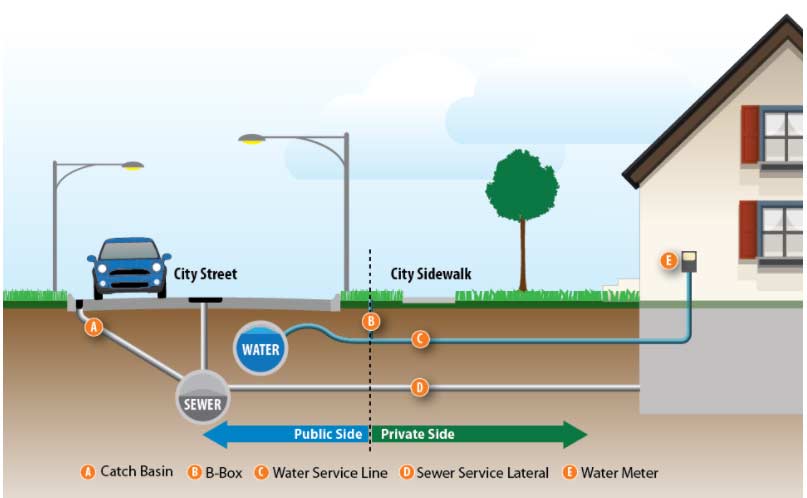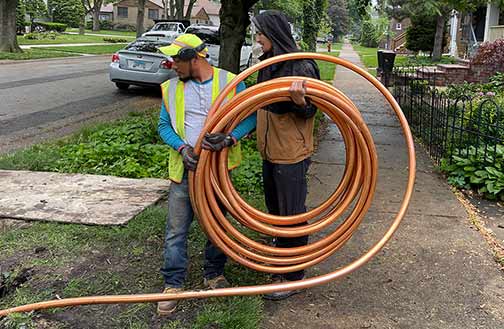
In 2021, the city of Chicago has initiated a program called the Lead Service Line Replacement (LSLR) plan designed to fast track the replacement of the city’s nearly 400,000 lead service lines. If you are a homeowner in Chicago, you need to know what this program is about and how to take advantage of incentives being offered by the city to replace your lead service line. Same goes for landlords and property owners, says EvolveNV.
What is the Lead Service Line Replacement (LSLR) plan?
A service line is a pipe that carries water from the city’s main water supply in the street to your home. The pipe runs underground from your home, across the lawn, and underneath the city sidewalk until it reaches the water main below the street.
Why does the city want you to replace your service line?
Only service lines made of lead are being replaced. This is because of the health hazard posed by exposure to the lead in these pipes. Even the lowest level of lead exposure has been shown to adversely affect the IQ of children and their attention spans.
Although most lead poisoning happens via contact with lead-based paint or lead-contaminated dust, lead may also leach into drinking water from the lead service line. Since there is no identified safe level for lead exposure, the best way to prevent this issue is to replace the lead water lines on your Chicago property.
How will you know if you have a lead service line?
If your house or two-flat building was built before 1986 and the water service has never been replaced during renovation, there is a big chance the water service line is made of lead. If you are not sure, here is a simple test to identify the material in your water service line.
- Step one: Locate the water meter or shutoff valve in your home. The service line typically enters through the basement before it connects to the meter. If you can’t find the meter, use the shutoff valve.
- Step two: Hold a magnet to the pipe to check if it is magnetic.
- Step three: Scratch the pipe with a coin or key to see the color of the material.
The pipe should be made of one of these materials:
- Copper: Copper is not magnetic. It has a shiny orange appearance and is quite common in Chicago.
- Galvanized steel: Steel is magnetic. It is silver-gray and is no longer used in new construction.
- Lead: Lead is not magnetic. It has a shiny silver-gray color and is not used in new construction.
- PVC: PVC plastic is not magnetic. It is typically white and is rarely used in Chicago.
What does replacing a water service line entail?
Replacing the water service line is a labor-intensive process that involves digging a trench from your home to the street, up to the point where the service line connects to the water main. After the trench is dug, the old lead line is replaced with a new copper service line. A water meter is also installed to help you save money on any spiking water bills.

Replacing the water service line is a labor-intensive process that involves digging a trench from your home to the street, up to the point where the service line connects to the water main.
Will the City of Chicago help with your lead service line replacement?
To assist as many homeowners as possible with their lead service line replacement, the city of Chicago is accepting applications for the Equity Lead Service Line Replacement Program. Under the program, homeowners are eligible for free lead service line replacement plus a free water meter, if:
- They live in a home they own.
- Have a child under 18 years old living in the home, or
- Their water has elevated lead level as shown by a free test by the Department of Water Management, and
- The household income is 80% below the area median income, which is $74,550 for a family of 4.
But for homeowners who do not meet the criteria, the city still offers incentives. These are for homeowners who hire a private contractor to replace their lead service line and the incentives are available in the form of waivers and freebies. Commercial and mixed-use residential/commercial properties are not eligible for this. Here is how it works.
- The homeowner will pay for the lead service line replacement (LSLR).
- The city will subsidize the standard permits, allowing homeowners to save as much as $3,100.
- The city will attach the new service line to the water main free of charge and provide a free water meter for the home (if there is none).
But to qualify, this must be a standalone project, and not part of a home renovation or expansion. Additionally, the contractor must be licensed.
When selecting a contractor for LSLR, homeowners are encouraged to follow the below process:
- Contact three licensed Chicago plumbers to request quotes and qualifications information.
- The plumber should visit the home to confirm service line material and other details.
- The plumber should have an Illinois Department of Public Health (IDPH) Plumbing Contractor License Number and must be on the list of City of Chicago-Licensed Plumbing Contractors.
- The plumber should be able to provide a list of 3-5 addresses where they have acquired a City of Chicago Department of Buildings permit for residential LSLR (with details of those projects).
—